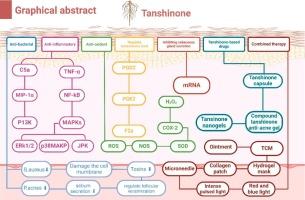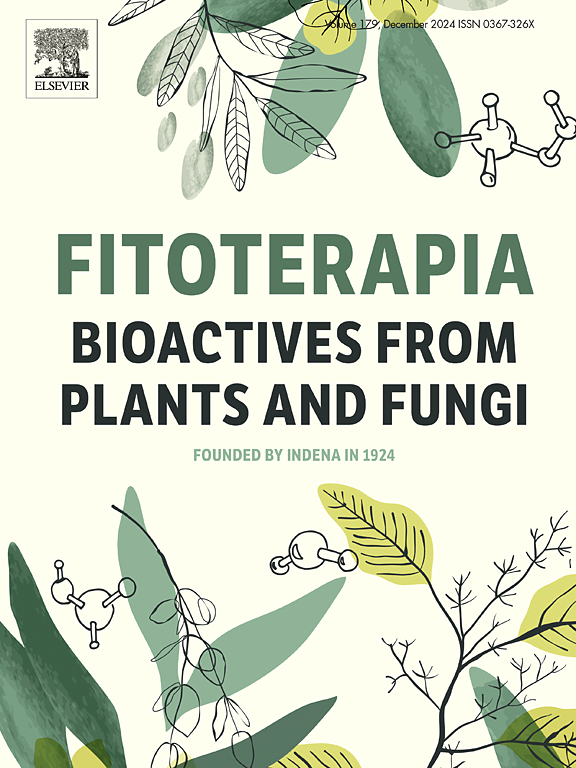Tanshinone in acne therapeutics: Integrating molecular mechanisms, drug development, and multimodal treatment strategies
IF 2.6
3区 医学
Q3 CHEMISTRY, MEDICINAL
引用次数: 0
Abstract
Tanshinones (TS), bioactive lipophilic diterpenoids derived from Salvia miltiorrhiza(SM), demonstrate significant therapeutic promise for acne vulgaris (AV)—a multifactorial dermatosis characterized by P.acnes colonization, aberrant follicular keratinization, and immune-inflammatory cascades exacerbated by endocrine dysregulation and psychosocial stressors. This comprehensive review synthesizes recent advances elucidating TS's tripartite mechanistic framework: (1) Direct antibacterial activity against P. acnes and multidrug-resistant Staphylococcus aureus, disrupting biofilm formation and quorum sensing; (2) Immunomodulation via suppression of NLRP3 inflammasomes, inhibition of MAPK/NF-κB signaling pathways, and downregulation of pro-inflammatory cytokines; (3) Sebostatic and antioxidant effects through modulation of SREBP-1/FASN-mediated lipid biosynthesis, Nrf2/ARE pathway activation, SOD/COX-2 regulation, and potent ROS scavenging. Innovations in pharmaceutical engineering—including carrier-free self-assembled nanoparticles, autolytic microneedle arrays, photoactivated nanoemulsions, and chitosan-based nanoencapsulated gels—have markedly enhanced TS bioavailability, dermal retention, and pilosebaceous targeting. Clinical evaluations confirm TS formulations significantly reduce inflammatory lesion counts, acne recurrence rates, serum testosterone, and oxidative stress biomarkers. Synergistic regimens combining TS with photodynamic therapy, intense pulsed light, or conventional agents demonstrate enhanced anti-acne efficacy while minimizing cutaneous irritation. Despite promising outcomes, translational challenges persist, including pharmacokinetic limitations, clinical validation gaps in long-term safety, and scale-up complexities of advanced delivery systems. Future research should prioritize randomized multicenter trials, predictive ex vivo models, and hybrid delivery platforms to accelerate evidence-based integration into dermatological practice.

丹参酮治疗痤疮:整合分子机制,药物开发和多模式治疗策略
丹参酮(TS)是一种从丹参(SM)中提取的生物活性亲脂二萜,对寻常痤疮(AV)有显著的治疗前景。寻常痤疮是一种多因素皮肤病,其特征是痤疮P.acnes定形,异常滤泡角化,以及内分泌失调和社会心理压力加剧的免疫炎症级联反应。本文综合综述了近年来阐明其三重机制框架的最新进展:(1)对痤疮链球菌和耐多药金黄色葡萄球菌的直接抗菌活性,破坏生物膜的形成和群体感应;(2)通过抑制NLRP3炎性小体、抑制MAPK/NF-κB信号通路、下调促炎细胞因子进行免疫调节;(3)通过调节SREBP-1/ fasn介导的脂质生物合成、Nrf2/ARE通路激活、SOD/COX-2调节和有效的ROS清除来调节油脂和抗氧化作用。制药工程方面的创新——包括无载体自组装纳米颗粒、自溶微针阵列、光活化纳米乳液和壳聚糖基纳米胶囊凝胶——显著提高了TS的生物利用度、皮肤保留率和皮脂腺靶向性。临床评估证实,TS制剂可显著降低炎症病灶计数、痤疮复发率、血清睾酮和氧化应激生物标志物。协同方案结合TS光动力疗法,强脉冲光,或传统药物显示增强抗痤疮功效,同时最大限度地减少皮肤刺激。尽管取得了令人鼓舞的成果,但转化方面的挑战仍然存在,包括药代动力学限制、长期安全性的临床验证差距以及先进给药系统规模扩大的复杂性。未来的研究应优先考虑随机多中心试验、预测离体模型和混合给药平台,以加速循证整合到皮肤科实践中。
本文章由计算机程序翻译,如有差异,请以英文原文为准。
求助全文
约1分钟内获得全文
求助全文
来源期刊

Fitoterapia
医学-药学
CiteScore
5.80
自引率
2.90%
发文量
198
审稿时长
1.5 months
期刊介绍:
Fitoterapia is a Journal dedicated to medicinal plants and to bioactive natural products of plant origin. It publishes original contributions in seven major areas:
1. Characterization of active ingredients of medicinal plants
2. Development of standardization method for bioactive plant extracts and natural products
3. Identification of bioactivity in plant extracts
4. Identification of targets and mechanism of activity of plant extracts
5. Production and genomic characterization of medicinal plants biomass
6. Chemistry and biochemistry of bioactive natural products of plant origin
7. Critical reviews of the historical, clinical and legal status of medicinal plants, and accounts on topical issues.
 求助内容:
求助内容: 应助结果提醒方式:
应助结果提醒方式:


